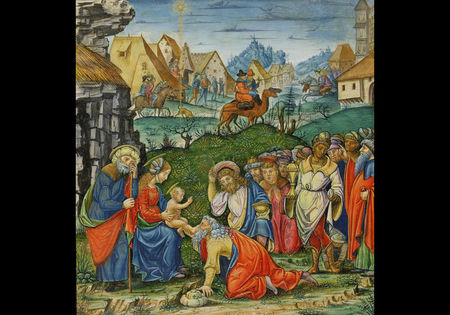'Pages of Gold: Medieval Illuminations from the Morgan' @ The Morgan Library & Museum
Virgin and Child with Female Saints, Leaf from a devotional book. Illuminated by Gerard David. Belgium, Bruges, ca. 1500. Purchased by Pierpont Morgan; MS M.659.
NEW YORK, NY.- Famous for its medieval and Renaissance manuscripts, The Morgan Library & Museum also holds a notable collection of single illuminated pages. Extracted from full texts, these works were acquired because they include some of the most spectacular examples of medieval painting, often with intricate designs brightened by burnished gold. From June 19 through September 13, 2009, in an exhibition entitled Pages of Gold: Medieval Illuminations from the Morgan, fifty of the Morgan’s finest single leaves—many of which were acquired by Pierpont Morgan and twelve of which are being displayed for the first time—are on view.
The centerpiece of the exhibition is the finest leaf from the celebrated Winchester Bible, arguably the most lavish English Bible of its time. Made in Winchester during the last quarter of the twelfth century, it contains vivid scenes from the lives of Samuel and David and was the last leaf acquired by Mr. Morgan. Also included in the show are works of Italian, French, Flemish, German, Hungarian, and Spanish origin.
“Pages of Gold offers a new take on one of the core strengths of the Morgan, its unrivaled holding of illuminated manuscripts,” said William M. Griswold, the Morgan’s director. “While no longer in their original context within a book, seeing individual pages mounted and framed allows one to focus on the quality of each illumination as a small painting. It is also fascinating, given the broad geographical range of the show, to see the stylistic differences that distinguish one region or period from another.”
Although miniatures and illuminated initials were occasionally removed from manuscripts, they were not collected systematically before the nineteenth century. A pivotal turning point was when Luigi Celotti, an Italian abbot turned dealer, acquired looted choir books from the Sistine Chapel in 1798. Celotti cut out their miniatures and decorated borders to avoid transporting the large and heavy volumes to England, where the miniatures, as well the montages he made from the decorated borders, were sold at a landmark sale held at Christie’s auction house in London in 1825.
One of Celotti’s best preserved and most spectacular montages, on view for the first time, opens the exhibition. Fragments of the composite leaf originally came from a book commissioned by Pope Clement VII (r. 1523–34) or his cousin Pope Leo X (r. 1513–21) for use in the Sistine Chapel. The page comprises five separate panels. Two vertical side panels include classical decoration, medallions with figures of evangelists, a pope, and a bishop and the emblem of Clement VII. At the center of the montage is a miniature by Vincenzo Raimondi of the Birth of John the Baptist, depicting Elizabeth handing her swaddled newborn to a woman, while Zachariah writes the name of his son on a scroll.
Notable examples from the collection of William Young Ottley, an art historian and early collector of single leaves, include works excised from the twelfth-century Eadwine Psalter from Canterbury. The two double-sided leaves each contain seventy-seven small miniatures depicting scenes from the lives of Moses, Joshua, Saul, David, and Christ. Ottley cataloged the 1825 Celotti London sale at Christie’s, and his own collection of single leaves was sold as “illuminated miniature paintings” at Sotheby’s in 1838.
Pages from a richly decorated book made for Hungarian royalty (ca. 1325–35) are also on view. Each of its leaves originally contained four distinct scenes, but they were cut and mounted individually during the seventeenth century. The exhibition includes several leaves in which the scenes have been reunited as well as the book in which the cut pages were mounted.
Among the Italian works is a group of cut initials and leaves from a set of choir books illuminated in Florence by Silvestro dei Gherarducci during the 1390s. The initials included illustrations of prophets within the letters and were particularly popular because they contain heavily burnished gold.
In addition to leaves from Northern Europe—notably France, the Netherlands, Germany, and Bohemia—there are two Spanish choir book leaves on view that are over three feet tall. They were likely illuminated in Castile for a convent in the early sixteenth century.
The Spanish section ends with examples by the infamous Spanish Forger. Active in Paris during the early twentieth century but never identified, the Spanish Forger was named by the Morgan’s first director, Belle da Costa Greene, for a work that was thought to be of medieval Spanish origin. Recognizing the growing turn-of-the-century interest in collecting single leaves, the Spanish Forger created over 240 of them for an unsuspecting public. His work is notable for its distinct style and charm and is now collected in its own right.
Adoration of Magi, Cutting from a Gradual, in Latin. Illuminated by Master B. F. Italy, Milan, ca. 1500. The Morgan Library & Museum; MS M.725.

/https%3A%2F%2Fprofilepics.canalblog.com%2Fprofilepics%2F1%2F0%2F100183.jpg)




/http%3A%2F%2Fp9.storage.canalblog.com%2F92%2F51%2F119589%2F98216442.jpg)
/https%3A%2F%2Fassets.over-blog.com%2Ft%2Fcedistic%2Fcamera.png)
/https%3A%2F%2Fstorage.canalblog.com%2F77%2F60%2F577050%2F66527770_o.jpg)
/https%3A%2F%2Fstorage.canalblog.com%2F91%2F69%2F577050%2F66524735_o.jpg)